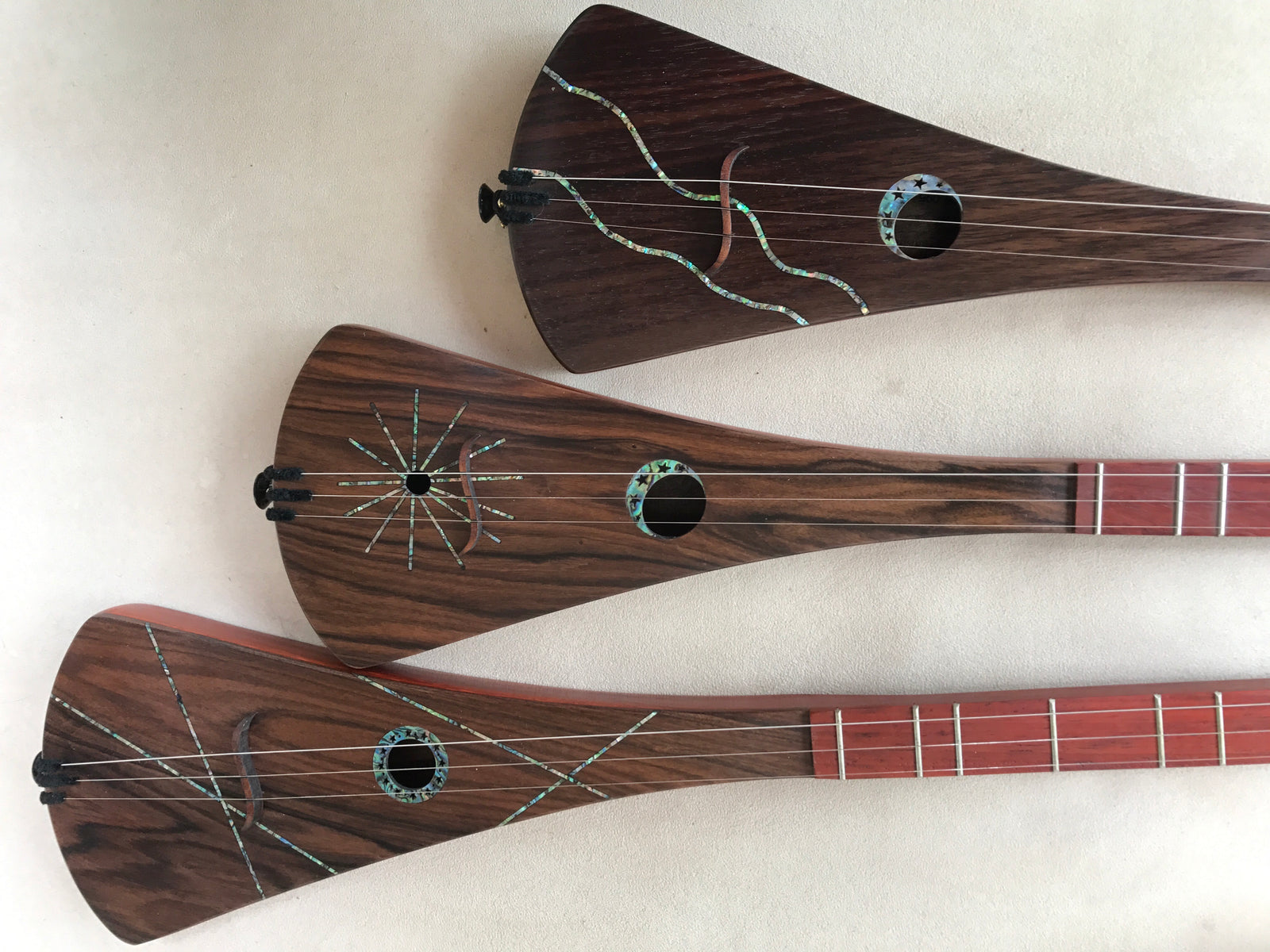Best Seller Strumstick
Products
Announcing a new instrument, the 3-String MiniSlide. This is a little Lap Steel-type instrument, that you play on your lap or on a table. A metal slide bar is held against the strings, and slides from note to note , like a Lap Steel or Dobro. There are no frets, but there is a “fingerboard” underneath the strings with lines to indicate the positions of the 12 notes of a chromatic scale.
See the MiniSlide Support Page for more videos
What is unique about the MiniSlide??
• It has only three strings (tuned DAD).
• It is an electric instrument, but we added a small oval soundbox so it can be played quietly without plugging in.
• The note position lines are longer to indicate a D major Scale (like the Strumstick) and shorter for the rest of the chromatic scale.
• For the benefit of the beginner, it is biased towards one key (D), but it is still a fully chromatic instrument.
The unique features of the MiniSlide offer a more gentle learning curve, and quicker access to slide sounds for beginners to the instrument.
Available with Maple body with contrasting fingerboard and soundboard. Prices are $580 with slotted note lines, $730 with Abalone inlay note lines
Sapele or Walnut body special order, write for lead time, $100 additional.
MiniSlide Features
A. Instead of being tuned to a major chord, the Minislide is tuned DAD (like the Strumstick). Anywhere you place the slide is a "power chord" (1 5 1), neither major nor minor but substituting for either. Chord accompaniment is much easier to manage with the MiniSlide. This is not a knock on other slide instruments. It's a feature of the MiniSlide that helps Beginners enjoy what they are doing sooner, and to develop the basic skills that will serve you well if you go on to more complex slide instruments.
B. The Main Scale: Conventional Lap Steels have position lines ("Fret Lines") to show where the all the frets would be, in a chromatic scale (all the notes) like on a guitar. On the MiniSlide we used longer lines to show a basic D major scale (like the Strumstick). We call this the main Scale. You can easily play in key of D by using the longer fret lines. Shorter lines are located for the in-between notes. If you want to be in other keys, you will have to memorize what combination of long and short lines you need for the desired key. (just like you have to for ANY key on other slide instruments). It is a great help to have one major scale "spelled out" while you are beginning to play.
C. Playing in tune is a critical skill with any slide instrument, because small changes of the slide position change the pitch. It is easier to position the slide accurately with only 3 strings compared to 6. Your intonation will get better and better as you play and listen. On guitar frets give people fixed pitches to work within. Slide instruments do not offer that scaffolding, but the Main Scale of the MiniSlide is a great assist as you are learning to position the slide accurately. Playing slide in tune is part Ear, part Eye, part Muscle Memory, and a lot of practice. Working with a "fixed" main Scale speeds that process. it also gets you playing tunes quicker. The more fun you have while learning, the more you play and the faster you learn.
D. 3 strings make Strumming a very useful technique with the MiniSlide, unlike with Lap Steels which are mostly fingerpicked. You can learn fingerpicking very easily with the MiniSlide, but you can also do strumming and flatpicking for a wider range of styles.
E. The Semi-Acoustic sound chamber of the MiniSlide is loud enough for you to practice without plugging into an amp, and is a cool little sound all by itself. It also lets you work on playing quietly with others in "stealth" mode. Sooner or later you will want to play along with others. Stealth mode (unplugged) lets you hear enough to be in control of what you are playing without your inevitable errors ruining somebody else's song.
All these features are designed to make the entry curve to basic playing much easier. I have been practicing what I preach. I have been learning to play in tune, gradually but steadily. Most of my practice time has been demonstrating the MiniSlide at Art Fairs, mostly using the MiniSlide Main Scale. As I anticipated, it is easier to refine my playing in tune when I'm not also having to keep track of what scale I am playing in.
Two signature sounds of slide instruments are sliding into notes, and a wide vibrato when you arrive at a note. Vibrato is wiggling the tone bar left and right (about 1/4 inch on either side), oscillating around your intended note. Besides being a great sound, it masks the danger of being a little sharp or flat if you are just hitting a note from scratch. Works with chords too. Sliding from one note to another is what slide is all about, and its actually easier to arrive at an in-tune note by sliding to it, hearing the change happen, than it is by flying in from space and landing in the exact perfect position. It is worth noting that the two signature elements of slide playing also serve to make playing slide a little easier.
Sales, New Products, Instructions, Videos, and Free Offers, Useful Content.
